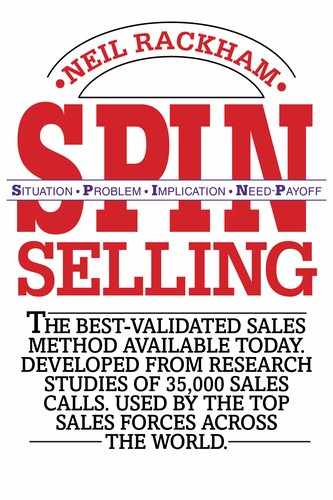Preface
This is yet another book about how to sell more successfully. So what makes it different from the more than 1000 sales books already published? Two things:
1. It’s about the larger sale. Almost all existing books on selling have used models and methods that were developed in low-value, one-call sales. In the 1920s, E. K. Strong carried out pioneering studies of small sales that introduced such new ideas to selling as features and benefits, closing techniques, objection-handling methods, and open and closed questions. For more than 60 years, these same concepts have been copied, adapted, and refined with the assumption that they should apply to all sales. Even the few writers who have tried to give some advice on larger sales have based many of their ideas on these older models. And that’s a mistake, because the traditional strategies of how to sell just don’t work in the fast-moving and complex environment of today’s major sale.
This, I believe, is the first book to take a completely fresh look at larger sales and the skills you need to make them succeed. As you’ll see, many of the things that help you in smaller sales will hurt your success as the sale grows larger. Major sales demand a new and different set of skills, and that’s what this book is about.
2. It’s based on research. This is the first publication of results from the largest research project ever undertaken in the selling-skills area. My team at Huthwaite analyzed more than 35,000 sales calls, over a period of 12 years, to provide the hard facts on successful selling that you’ll read here. There are plenty of opinions on how to sell, but a real shortage of well-researched facts. I carried out the research described in this book because I wasn’t satisfied with opinions. I wanted proof. And now, after a million dollars of research, I can give you well-documented evidence about how to be more successful in larger sales.
I’m writing for those who are serious about selling—who see their selling as a high-level profession needing all the skill and care that go with professionalism in any field. And I’m writing about how to make major sales—that significant business which has the margins and rewards attractive to high-level sales professionals. In our studies we’ve worked with top salespeople from more than 20 of the world’s leading sales organizations. From watching them in action during major sales, we’ve been able to find out what makes them so successful. That’s the subject of this book.
But how do you know that the methods I’ll be describing can help you be more effective? I’m confident that they will, and my confidence is based on something more substantial than just hope. When we first discovered the methods described in this book, we weren’t sure whether they would help people sell more effectively. For one thing, many of our findings were controversial and directly contradicted most existing sales training; for another, we weren’t sure whether the methods used by successful professionals would be too difficult for most people to learn.
So we kept quiet about our findings for 7 years, testing out the practical value of our ideas before we were ready to publish them. During that time we trained several thousand salespeople in the methods we describe here, continuously experimenting to find the best way to turn our theoretical knowledge of sales success into simple and practical methods that could help anyone become more effective in major sales. We measured the productivity gains of the first thousand people we trained, comparing them with control groups from the same companies. The people we’d trained showed an average increase in sales volume of 17 percent more than the control groups. Consequently, I’m confident that this book gives well-tested methods for increasing sales results. It’s already helped thousands of people be more successful in larger sales—and it can give the same help to you.
More than 10,000 sales people in 23 countries generously agreed to let Huthwaite researchers travel with them and observe them in action during sales calls. This book is about them and for them with our thanks. Then I must thank upwards of 1000 sales managers who have been part of programs we’ve run across the world and who have helped refine the ideas I’m presenting here.
Finally, at last count, there were more than 100 people who were closely involved in the research itself and in the development of our ideas. I can’t include them all, but special mention must go to Peter Honey and Rose Evison, who worked with us to develop the original behavior-analysis methodology we used in our research. From this methodological base, we were able to produce some initial measurement instruments that let us take the first-ever scientific, quantitative look at sales calls. In those early stages Roger Sugden deserves special mention as the first member of the Huthwaite research team to use these early methods.
For the development of the SPIN Model itself, thanks should go to Simon Bailey and Linda Marsh, who helped during the initial field studies to validate the SPIN Model. Many other Huthwaite colleagues have helped, including Dick Ruff and John Wilson, whose experience as trainers has given me valuable insights into how to express many of the concepts I describe here. Also my thanks to Joan Costich, who helped me revise the manuscript, and to Elaine Ailsworth, who prepared the illustrations.
People outside Huthwaite who have made substantial contributions include Masaaki Imai of the Cambridge Corporation, who has adapted our models to fit the fascinating Japanese sales environment; Jan van den Berg of McKinsey and Co., who has forced me to express these concepts in fewer words than I thought decent; and Harry Gaines, whose instincts for layout and presentation have changed the shape of the book.
